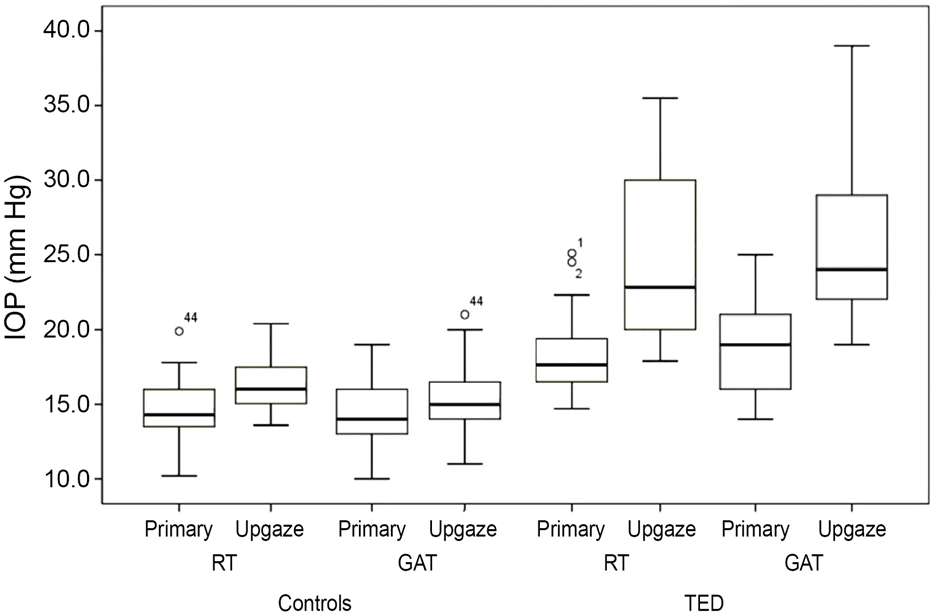1. Nardi M, Bartolomei MP, Romani A, Barca L. Intraocular pressure changes in secondary positions of gaze in normal subjects and in restrictive ocular motility disorders. Graefes Arch Clin Exp Ophthalmol. 1988; 226:8–10.
2. Saunders RA, Helveston EM, Ellis FD. Differential intraocular pressure in strabismus diagnosis Ophthalmology. 1981; 88:59–70.
3. Zappia RJ, Winkelman JZ, Gay AJ. Intraocular pressure changes in normal subjects and the adhesive muscle syndrome. Am J Ophthalmol. 1971; 71:880–3.

4. Helveston EM, Bick SE, Ellis FD. Differential intraocular pressure as an indirect measure of generated muscle force. Ophthalmic Surg. 1980; 11:386–91.
5. Fishman DR, Benes SC. Upgaze intraocular pressure changes and strabismus in Graves' ophthalmopathy. J Clin Neuroophthalmol. 1991; 11:162–5.
6. Goldmann H, Schmidt T. Applanation tonometry. Ophthalmologica. 1957; 134:221–42.
7. Herzog D, Hoffmann R, Schmidtmann I. . Is gaze-dependent tonometry a useful tool in the differential diagnosis of Graves’ ophthalmopathy? Graefes Arch Clin Exp Ophthalmol. 2008; 246:1737–41.
8. Jorge J, Fernandes P, Queirós A. . Comparison of the IOPen and iCare rebound tonometers with the Goldmann tonometer in a normal population. Ophthalmic Physiol Opt. 2010; 30:108–12.

9. Fernandes P, Díaz-Rey JA, Queirós A. . Comparison of the ICare rebound tonometer with the Goldmann tonometer in a nor-mal population. Ophthalmic Physiol Opt. 2005; 25:436–40.
10. Nakamura M, Darhad U, Tatsumi Y. . Agreement of rebound tonometer in measuring intraocular pressure with three types of ap-planation tonometers. Am J Ophthalmol. 2006; 142:332–4.

11. Brusini P, Salvetat ML, Zeppieri M. . Comparison of ICare ton-ometer with Goldmann applanation tonometer in glaucoma patients. J Glaucoma. 2006; 15:213–7.

12. Martinez-de-la-Casa JM, Garcia-Feijoo J, Castillo A, Garcia-Sanchez J. Reproducibility and clinical evaluation of rebound tonometry. Invest Ophthalmol Vis Sci. 2005; 46:4578–80.

13. Kohlhaas M, Boehm AG, Spoerl E. . Effect of central corneal thickness, corneal curvature, and axial length on applanation tonometry. Arch Ophthalmol. 2006; 124:471–6.

14. Grieshaber MC, Schoetzau A, Zawinka C. . Effect of central corneal thickness on dynamic contour tonometry and Goldmann applanation tonometry in primary open-angle glaucoma. Arch Ophthalmol. 2007; 125:740–4.

15. Moreno-Montañés J, Gosende I, Caire J, García-Granero M. Comparation of the new rebound tonometer IOPen and the Goldmann tonometer, and their relationship to corneal properties. Eye (Lond). 2011; 25:50–6.

16. Moreno-Montañés J, García N, Fernández-Hortelano A, García-Layana A. Rebound tonometer compared with goldmann tonometer in normal and pathologic corneas. Cornea. 2007; 26:427–30.

17. Lee KS, Kim SK, Kim EK, Kim TI. Comparison of intraocular pressure measured by non-contact tonometer, rebound tonometer, tono-pen, and Goldmann applanation tonometer. J Korean Ophthalmol Soc. 2014; 55:47–53.






 PDF
PDF ePub
ePub Citation
Citation Print
Print


 XML Download
XML Download